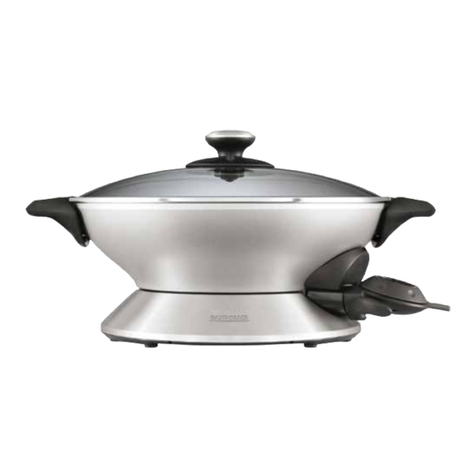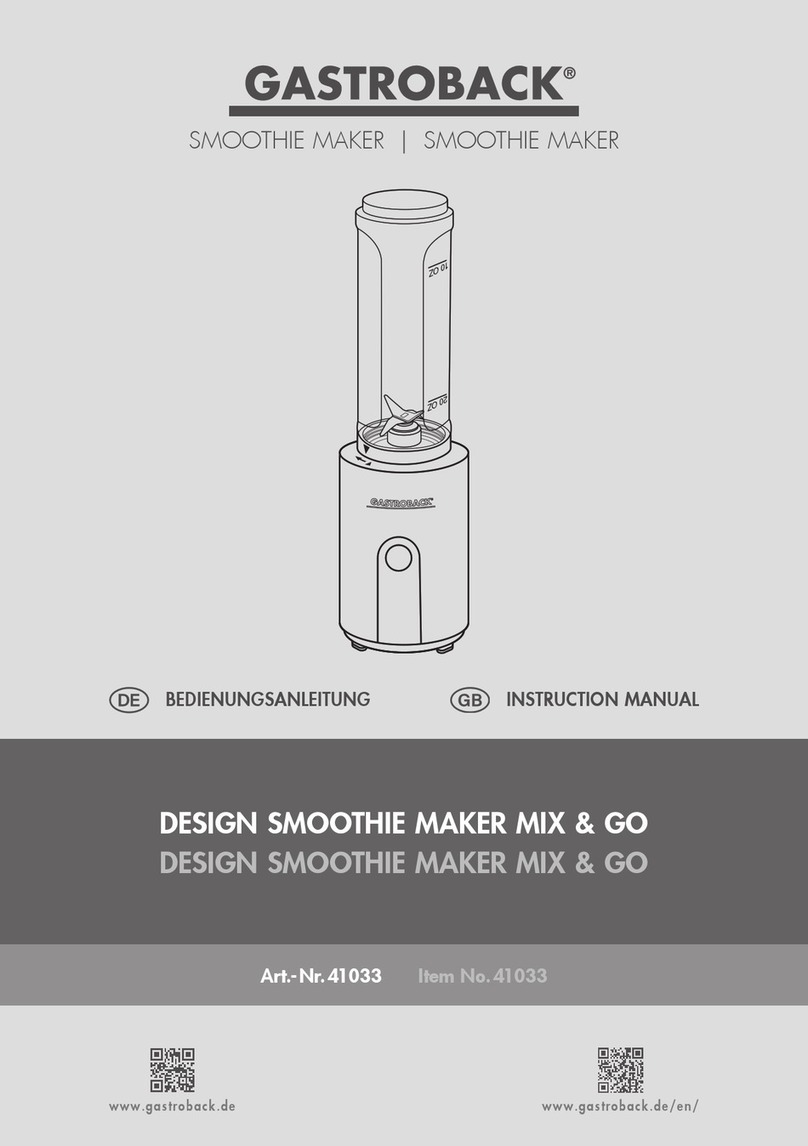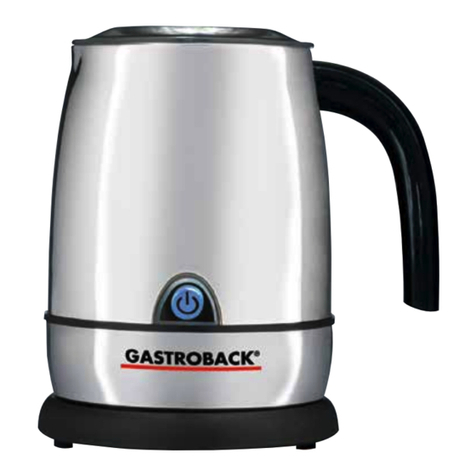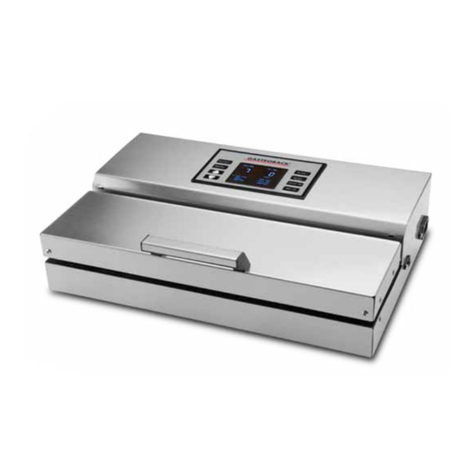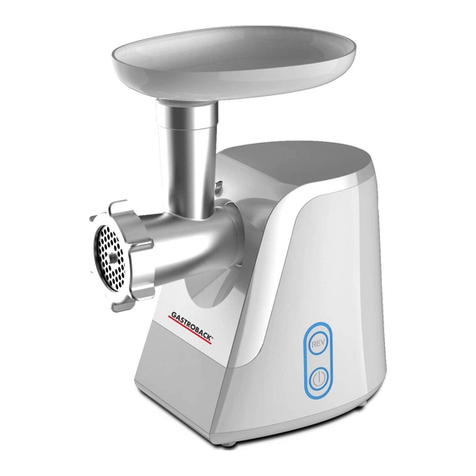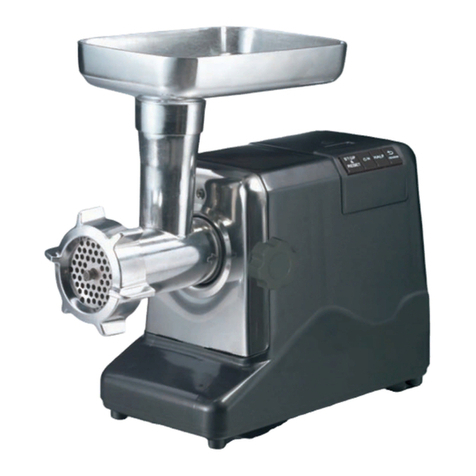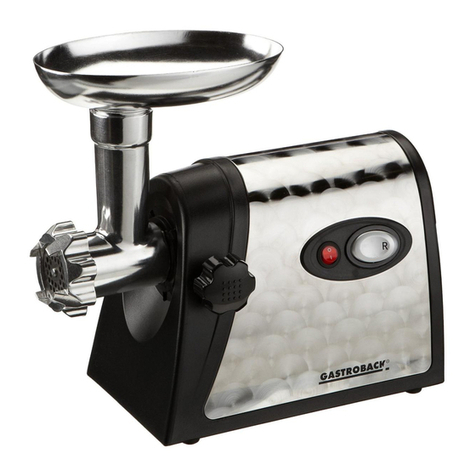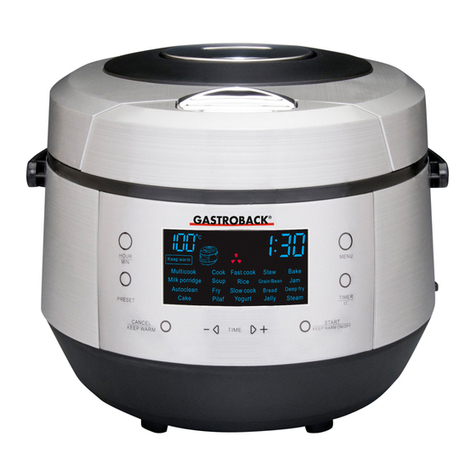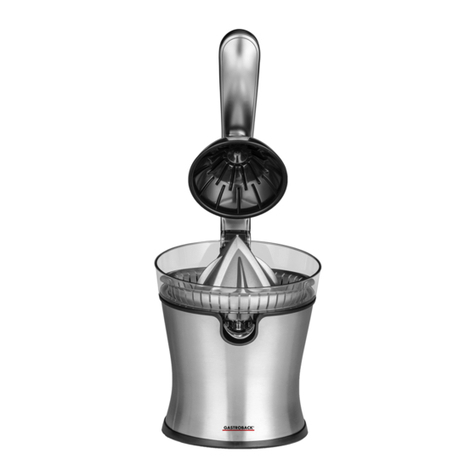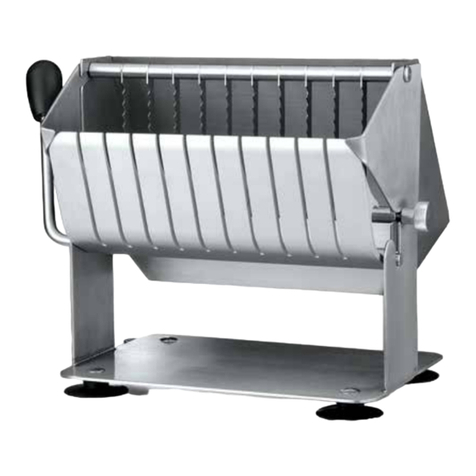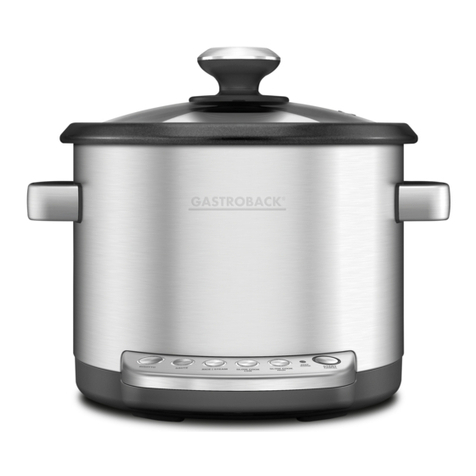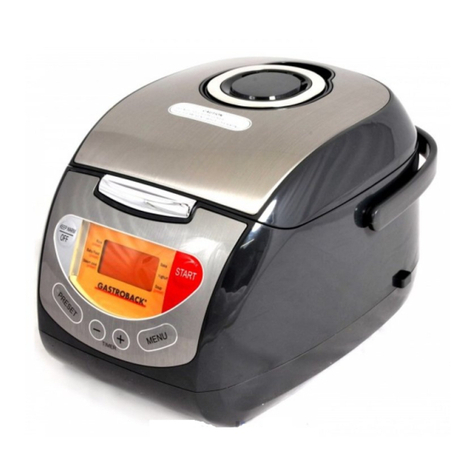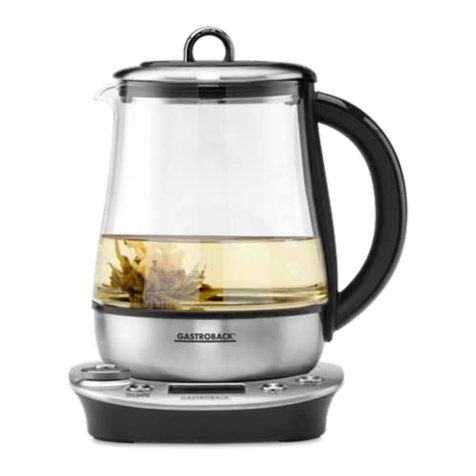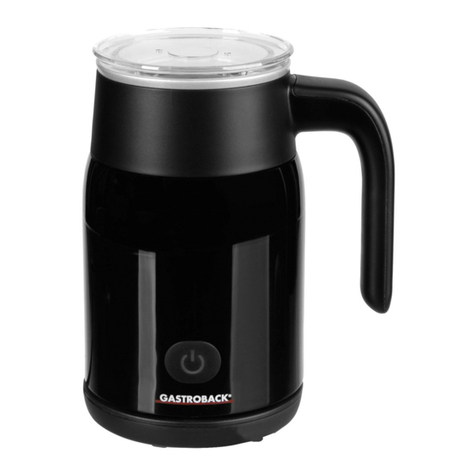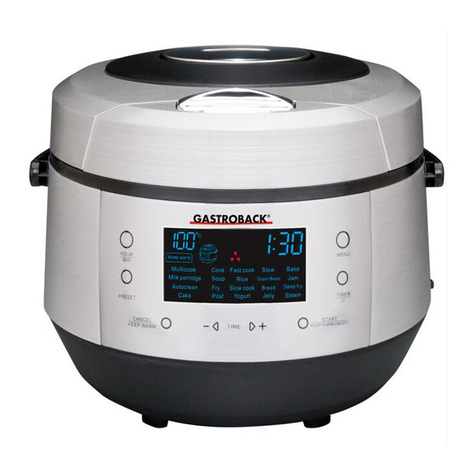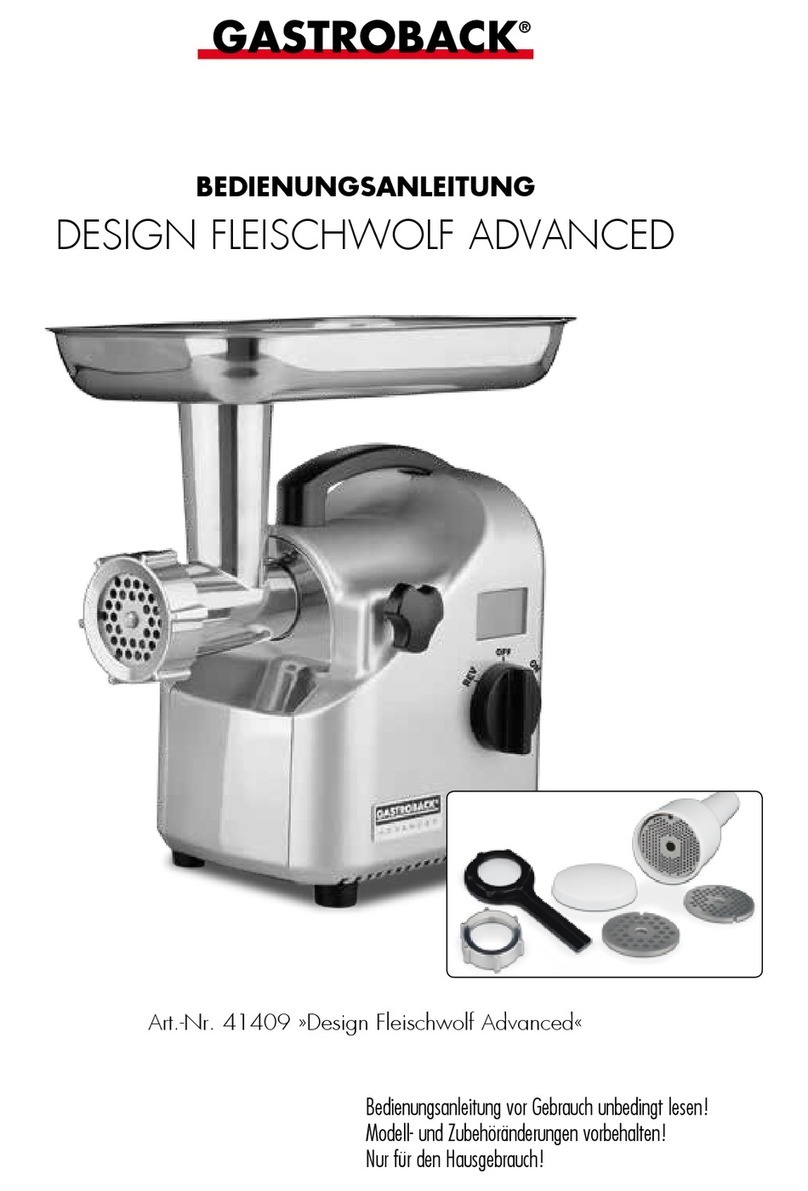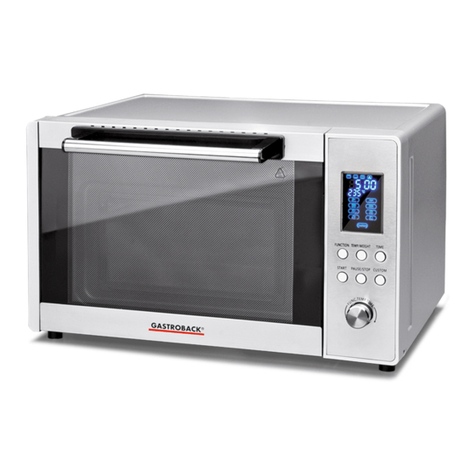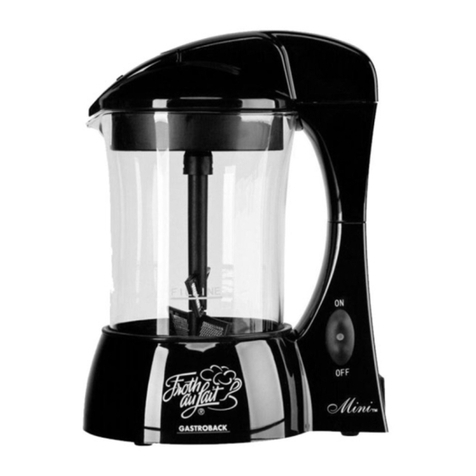
14 15
• Generell gilt für alle Eissorten: Abhängig von den Zutaten des Eises (Beispiel:
Wassereis, Milcheis oder Jogurt) muss das Eis bei der Verarbeitung mit dem Gerät
die richtige Temperatur haben. Als Faustregel gilt: Je höher der Gehalt an Zucker,
Fett und Eiweiß, umso kälter muss das Eis sein. Abhängig von der Eissorte müssen
Sie eventuell etwas experimentieren, um die gewünschten Ergebnisse zu erhalten.
• Kühlen Sie die abnehmbaren Bauteile des Geräts vor der Verarbeitung des
Eises. Wählen Sie dafür zumindest den kältesten Platz in Ihrem Kühlschrank (für
Wassereis) oder kühlen Sie die Teile sogar im Gefriergerät (Beispiel: Milcheis
oder gefrorener Jogurt).
• Denken Sie bitte daran, dass das Einfrieren in den mitgelieferten Eisformen des
Geräts 10-12 Stunden (bei -18°C) dauern kann. Wenn Sie selbst hergestelltes
Eis verarbeiten wollen, dann bereiten Sie die Lebensmittel deshalb am besten
am Vortag vor und frieren sie über Nacht ein.
• Eis aus klarem oder aromatisiertem Wasser und Fruchtsäften ist bei -18 °C
(typische Temperatur in Gefriergeräten) extrem hart. Lassen Sie das Eis kurz vor der
Verarbeitung mit dem Ice Shaver immer zuerst etwas antauen, um die Verarbeitung
zu erleichtern und eine lange Lebensdauer von Motor und Messer zu erreichen.
• Wärmen Sie das Eis zum Antauen NICHT mit warmem Wasser oder dem
Mikrowellenofen auf. Die Härte des Eises würde dadurch sehr ungleichmäßig.
Lassen Sie das Eis am besten für einige Zeit maximal bei Raumtemperatur oder
sogar im Kühlschrank stehen.
• Unter bestimmten Umständen können Sie Speiseeis mit einem hohen Gehalt an Zucker,
Fett und Eiweiß (Frozen Jogurt, Milcheis oder Sahneeis) mit dem Gerät zu Bändern
verarbeiten. Allerdings sind diese Eissorten auch bei Tiefkühltemperaturen (-18°C oder
kälter) ausreichend weich. Versuchen Sie, diese Eissorten sofort nach der Entnahme
aus dem Gefriergerät zu verarbeiten. In diesen Fällen ist es ganz besonders wichtig,
Stempelscheibe, Eisbehälter und Behältereinsatz des Geräts vor der Verarbeitung
mindestens 1 Stunde in das Gefriergerät zu stellen. Stellen Sie das Messer außerdem
auf einen groben Schnitt ein (Stellschraube im Uhrzeigersinn drehen).
• Eis lässt sich leichter aus einem Gefäß lösen, wenn Sie kurz kaltes Leitungswas-
ser über die Außenseiten des Gefäßes laufen lassen. Passen Sie auf, dass das
Eis dabei nicht herausfällt.
• Sofort nach der Verarbeitung einer Portion, können Sie den Eisbehälter neu füllen.
Achten Sie dabei aber darauf, dass der Motor nach 1 Minute kontinuierlichem
Betrieb ca. 10 Minuten Zeit zum Abkühlen braucht. Normalerweise werden Sie
diese zeitliche Grenze jedoch nicht erreichen, da das Gerät eine Portion Eis in den
meisten Fällen innerhalb von Sekunden verarbeitet. Eine Ausnahme könnte Eis aus
klarem oder aromatisiertem Wasser bilden, wenn Sie das Eis nach der Entnahme
aus dem Gefriergerät zu früh verarbeiten. Lassen Sie diese Eissorten vor der Verar-
beitung mit dem Gerät bitte zuerst etwas wärmer werden.
• Die Gefäße, in denen Sie das verarbeitete Eis auffangen wollen, müssen in
den Standfuß des Gerätes passen und eine möglichst weite Öffnung haben,
damit das Eis nicht daneben füllt. Auch für diesen Zweck sind die Eisformen des
Gerätes ideal. Sollten Sie allerdings passende Dessertschalen oder Getränkebe-
cher und Gläser zur Verfügung haben, dann kann das Gerät das Eis auch direkt
auf Ihr Dessert oder in Ihr Getränk geben.
• Je feiner Sie das Eis zerkleinert haben, umso schneller schmilzt es besonders
bei hohen Umgebungstemperaturen. Verarbeiten Sie das Eis deshalb am besten
erst direkt vor dem Verzehr. Sie können den Eisschnee für einige Zeit in einem
geschlossenen Gefäß im Gefriergerät aufbewahren. Allerdings ändern sich
Qualität und Beschaffenheit des Eises dann besonders schnell.
• Stellen Sie einen Teller oder ein Tablett bereit, um den Eisbehälter nach der Ver-
arbeitung des Eises abzustellen. Dadurch halten Sie Ihre Arbeitsfläche sauber und
vermeiden Stromschlaggefahr, Wasserschäden und Rutschgefahr durch Nässe.
BEDIENUNG
WARNUNG – Achten Sie zu jeder Zeit darauf, dass das Gerät
und alle seine Bauteile für Kinder unter 8 Jahren und Tiere unzugäng-
lich sind. Niemals das Gerät unbeaufsichtigt lassen, wenn es an die
Stromversorgung angeschlossen ist.
WARNUNG – Wenn Flüssigkeiten auslaufen (auch Schmelzwas-
ser und Kondenswasser), dann ziehen Sie sofort den Netzstecker aus
der Steckdose. Wischen Sie die Flüssigkeit ab und entfernen Sie herun-
tergefallenes Eis sofort. Ziehen Sie nach der Benutzung immer sofort den
Netzstecker aus der Steckdose, nehmen Sie den Eisbehälter aus dem Gerät
und stellen Sie den Eisbehälter danach auf einem Teller oder Tablett ab.
Dadurch verhindern Sie Schäden und eine Gefährdung durch Nässe.
WARNUNG – Gefahr von Erfrierungen: Vermeiden Sie längeren,
direkten Hautkontakt mit sehr kalten Gegenständen (vorgekühlte Geräte-
teile, Eis und tiefgefrorene Lebensmittel). Feuchte Haut kann an tiefge-
kühlten Gegenständen sofort festfrieren. Schützen Sie ihre Hände mit
Handschuhen.
Bitte beachten Sie die Hinweise im vorhergehenden Kapitel ‚Wichtige Verarbeitungshinweise‘.
WICHTIG - Wenn der Motor eine Minute kontinuierlich gearbeitet hat, dann
machen Sie eine Pause von ca. 10 Minuten, um eine Überhitzung des Motors zu
vermeiden. Bei normaler Verwendung werden Sie diese zeitliche Beschränkung
allerdings selten erreichen.
